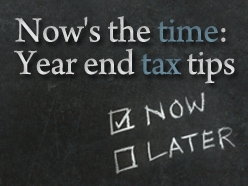
Canadians should be making a list of year-end tax considerations and checking it twice while they still have time, says EY.
Tax tips for the end of the year:
1. Contribute to a tax-free savings account (TSFA). Make sure your clients have made their $5,500 TFSA contributions for 2013, and if they haven’t contributed before, remind them they can contribute up to $25,500 before the end of the year. Remember that they can also fund their partners’ contributions without attracting the attribution rules.
2. Concentrate on education. Tell your clients not to forget to make registered education savings plan contributions before the end of the year for their children or grandchildren. With a contribution of $2,500 per child under age 18, the federal government will contribute a grant of $500, and if your clients have prior non-contributory years, the annual grant can be as much as $1,000.
3. Put money into a registered retirement savings plan (RRSP). The deadline for making deductible 2013 RRSP contributions is March 3, 2014. However, if one of your clients turned 71 in 2013, makes sure she makes her final RRSP contribution no later than December 31 (not 60 days after the end of the year).
Read: Four in 10 Canadians aren’t retiring on time
4. Pay any tax-deductible or tax-creditable expenses. A variety of expenses can only be claimed as deductions in a tax return if the amounts are paid by the end of the calendar year. That goes for interest, investment counsel/management fees, professional dues, spousal support and child-care costs. Charitable donations, political contributions, medical expenses, child fitness and arts program costs, tuition fees and transit pass costs that give rise to tax credits must also be paid in the year in order to be creditable.
5. Reduce or eliminate non-deductible interest. Interest on funds borrowed for personal purposes is not deductible. Where possible, your clients should consider using available cash to repay personal debt before repaying loans for investment or business purposes on which interest may be deductible.
6. Reduce your taxable automobile benefit. If one of your clients is an employee who uses an employer-provided car primarily for business, he may be eligible for a reduced standby charge and a lower alternate operating benefit, computed as one-half of the standby charge. He needs to advise his employer in writing before year end in order to have the alternate operating benefit apply.
Read: Save tax on company cars
7. Request reduced deductions at source. If your clients receive tax refunds because of deductible RRSP contributions, child-care costs or spousal support payments, they should consider requesting Canada Revenue Agency authorization to allow their employers to reduce tax withheld from their salaries for 2014.
8. Consider income-splitting loans after 31 December 2013. The prescribed interest rate applicable to the exemption from income attribution on intra-family loans increased to 2% for loans created in the final quarter of 2013. The prescribed interest rate returns to 1% for loans created in the first quarter of 2014.
9. Review your investment portfolio. Your client may want to sell securities that have lost money to reduce capital gains realized earlier in the year. If the losses realized exceed gains realized earlier in the year, they can be carried back and claimed against net gains in the preceding three years, and you should receive the related tax refund.
Read: 8 things to consider when tax-loss harvesting
10. Make capital acquisitions for business. Self-employed individuals and unincorporated business owners expecting to make capital purchases for their business should consider buying before year end to get a depreciation deduction for 2013.
11. Revisit your 2013 instalment requirement. The final 2013 instalment payment is due on December 15, 2013. However, if your client expects her 2013 final tax liability to be significantly lower than her 2012 liability, she may have already paid enough. She is entitled to base her instalment payment on her expected 2013 liability, but she shouldn’t underestimate her balance— if it ends up being insufficient, she will be faced with interest and possibly a penalty.
12. Remember to keep receipts. Although taxpayers aren’t required to include most receipts when filing, CRA randomly requests receipts as part of its post-assessment review.